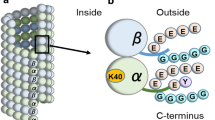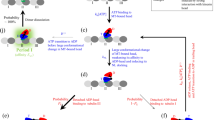Abstract
The relevance of protein phosphorylation, transphosphorylation and binding phenomena in the kinetics of the ATP-induced assembly of cycle-purified microtubule protein from mammalian brain were studied. ATP was able to induce the polymerization of microtubules of normal appearance. However, the assembled structures, were unstable and microtubules depolymerized after achievement of a transitory maximum. Cyclic AMP reduced the amplitude of the polymerization maximum in a concentration-dependent manner, correlating with the stimulation of the endogenous phosphorylation reaction. When microtubule assembly was induced by GTP, in the presence of various concentrations of ATP, the slope of the depolymerization phase was found to depend on the concentration of ATP. Fluoride ion inhibited the endogenous phosphorylation reaction and reduced the disassembly rate, in a concentration-dependent manner. Evidence is also presented indicating that ATP did not bind to phosphocellulose-purified tubulin. These results further contribute to indicate that ATP and cyclic AMP, acting coordinately to control the phosphorylation extent of microtubule proteins are important factors to determine microtubule stability within the cell. Some implications of this mechanism for the regulation by cAMP of the initiation of DNA synthesis and mitosis are considered.
Similar content being viewed by others
Abbreviations
- MAPs:
-
microtubule-associated proteins
- MAP2:
-
microtubule-associated protein 2, Mes-4-morpholinoethanesulfonic acid
- EGTA:
-
ethylene-glycol bis (β-aminoethyl ether)N,N,N′,N′-tetraacetic acid
- PMSF:
-
phenylmethylsulfonyl fluoride
- PEI:
-
polyethyleneimine
- PC:
-
phosphocellulose
- DEAE:
-
Diethylaminoethyl
- SDS-PAGE:
-
polyacrylamide gel electrophoresis in the presence of sodium dodecyl sulfate
References
Wang Z-W, Rozengurt E: Interplay of cyclic AMP and microtubules in modulating the initiation of DNA synthesis in 3T3 Cells. J Cell Biol 96:1743–1750, 1983.
Hsie AW, Puck TT: Morphological transformation of chinese hamster cells by dibutyryl adenosine cyclic 3′:5′-monophosphate and testosterone. Proc Natl Acad Sci USA 68:358–361, 1971.
Porter K, Puck TT, Hsie AW, Kelley D: An electron microscope study of the effects of dibutyryl cyclic AMP on chinese hamster ovary cells. Cell 2:145–162, 1974.
Willingham MC, Pastan I: Cyclic AMP and cell morphology in cultured fibroblasts. J Cell Biol 67:146–159, 1975.
Di Pasquale AM, McGuire J, Moellmann G, Wasserman SJ: Microtubule assembly in cultured greene melanoma cells is stimulated by dibutyryl adenosine 3′:5′-cyclic monophosphate or cholera toxin. J Cell Biol 71:735–748, 1976.
Nath K, Shay JW Bollon AP: Relationship between dibutyryl cyclic-AMP and microtubule organization in contracting heart muscle cells. Proc Natl Acad Sci USA 75:319–323, 1978.
Lacy PE, Howell SL, Young DA, Finck CJ: New hypothesis of insulin secretion. Nature (London) 219:1177–1179, 1968.
Williams JA, Wolf J: Possible role of microtubules in Thyroid secretion. Proc Natl Acad Sci USA 67:1901–1908, 1970.
Dicker P, Rozengurt E: Phorbol esters and vasopresin stimulate DNA synthesis via a common mechanism. Nature (London) 287:607–612, 1980.
Browne CL, Lockwood AH, Su IL, Beavo JA, Steimer AL: Immuno-fluorescent localization of cyclic nucleotide-dependent protein kinases on the mitotic apparatus of cultured cells. J Cell Biol 87:336–345, 1980.
Tash JS, Lagace L, Lynch DR, Cox SM, Brinkley BR, Means AR: Role of cAMP-dependent protein phosphorylation in microtubule assembly and function. In: Protein phosphorylation. Rosen OM and Krebs EW (eds) Cold Spring Harbor Laboratory, New York, 1980, pp 1171–1185.
Tash JS, Welsh MJ, Means AR: Protein inhibitor of cAMP-dependent protein kinase: Production and characterization of anti-bodies and intracellular localization. Cell 21:57–65, 1980.
Vallee RB, Di Bartolomeis MJ, Theurkauf WE: A protein kinase bound to the projection portion of MAP2. J Cell Biol 90:568–576, 1981.
Raff E: The control of microtubule assembly in vivo. Int Rev Cytol 59:1–96, 1979.
Kirkland WL, Burton PR: Cyclic adenosine monophosphate-mediated stabilization of mouse neuroblastoma cell neurite microtubules exposed to low temperature. Nature New Biol 240:205–207, 1972.
Shapiro DL: Morphological and biochemical alterations in foetal rat brain cells cultured in the presence of monobutyryl cyclic AMP. Nature (London) 241:203–204, 1973.
Sommers KD, Weberg AD, Steimer S: Cyclic AMP induced morphological transformation of cells infected with temperature-sensitive mouse sarcoma virus. Expression of transformation-associated markers. J Cell Biol 74:707–716, 1977.
Melmed RN, Karanian PJ, Berlin RD: Control of cell volume in the j 774 macrophage by microtubule disassembly and cyclic AMP. J Cell Biol 90:761–768, 1981.
Manso-Martinez R, Palomares R, Pariente F: Mammalian brain microtubules are sensitive to cyclic AMP in vitro. Arch Biochem Biophys 235:196–203, 1984.
Jacobs M, Smith H, Taylor EW: Tubulin-nucleotide binding and enzymic activity. J Mol Biol 89:455–468, 1974.
Weisenberg RC, Decry WJ, Dickinson PJ: Tubulin-nucleotide interactions during the polymerization and depolymerization of microtubules. Biochemistry 15:4248–4254, 1976.
Penningroth SM, Kirschner MW: Nucleotide binding and phosphorylation in microtubule assembly in vitro. J Mol Biol 115:643–673, 1977.
Zabrecky JR, Cole RD: Binding of ATP to tubulin. Nature (London) 296:775–776, 1982.
Pariente F, Palomares R, Luduena RF, Manso-Martinez R: Effects of ATP and cyclic AMP on the in vitro assembly and stability of mammalian brain microtubules (Abstr). J Cell Biol 101:276a, 1985.
Shelanski ML, Gaskin F, Cantor CR: Microtubule assembly in the absence of added nucleotides. Proc Natl Acad Sci USA 70:765–768, 1973.
Williams RC, Lee Jr JC: Preparation of tubulin from brain. In: DW Frederiksen and LW Cunningham (eds) Methods in Enzymology. Academic Press, New York, 1982, vol 85, pp 376–385.
Zabrecky JR, Cole RD: Effect of ATP on the kinetics of microtubule assembly. J Biol Chem 257:4633–4638, 1982.
Lowry O, Rosebrough N, Farr A, Randall R: Protein measurement with the Folin phenol reagent. J Biol Chem 193:265–275, 1951.
Laemmli UK: Cleavage of structural proteins during the assembly of the head of bacteriophage T4. Nature (London) 227:680–685, 1970.
Reimann EM, Walsh DA, Krebs EG: Purification and properties of rabbit skeletal muscle adenosine 3′,5′-monophosphate-dependent protein kinases. J Biol Chem 246:1986–1991, 1971.
Maccioni RB, Seeds NW: Enhancement of tubulin assembly as monitored by a rapid filtration assay. Arch Biochem Biophys 185:262–271, 1978.
Bradford MM: A rapid and sensitive method for the quantitation of microgram quantities of protein utilizing the principle of protein-dye binding. Anal Biochem 72:248–254, 1976.
Corces VG, Manso-Martinez R, de la Torre J, Avila J, Nast A, Wiche G: Effects of DNA on microtubule assembly. Eur J Biochem 105:7–16, 1980.
Hummel JP, Dreyer WJ: Measurement of protein-binding phenomena by gel filtration. Biochem Biophys Acta 63:530–532, 1962.
Islam K, Burns R: Multiple phosphorylation sites of microtubule-associated protein MAP2 observed at high ATP concentrations. FEBS Lett 123:181–185, 1981.
Palomares R, Prasad V, Luduena RF, Manso-Martinez R: Endogenous phosphorylation of microtubule protein by GTP: Mechanism of phosphate transfer and implications for the stability of assembled structures (Abstr). J Cell Biol 101:32a, 1985.
Sloboda RD, Rudolph SA, Rosenbaum JL and Greengard P: Cyclic AMP-dependent endogenous phosphorylation of a microtubule-associated protein. Proc Natl Acad Sci USA 72:177–181, 1975.
Garland DL: CAMP inhibits the in vitro assembly of microtubules. Arch Biochem Biophys 198:335–337, 1979.
Johnson KA, Borisy GG: Kinetic analysis of microtubule self-assembly in vitro. J Mol Biol 117:1–31, 1977.
Carlier M-F: Kinetic evidence for a conformation change of tubulin preceding microtubule assembly. J Biol Chem 258:2415–2420, 1983.
Islam K, Burns RG: Assembly of microtubules with ATP: Evidence that only a fraction of the protein is assembly competent. FEBS Lett 178:264–270, 1984.
Luduena RF, Roach MC, Treka PP, Little M, Palanivelu P, Brinkley P, Prasad V: β2-tubulin a form of chordate brain tubulin with lesser reactivity toward an assembly-inhibiting sulfhydryl-directed cross-linking reagent. Biochemistry 21:4787–4794, 1982.
Weisenberg RC: Role of co-operative interactions, microtubule-associated proteins and guanosine triphosphate in microtubule assembly: A model. J Mol Biol 139:660–677, 1980.
Bayley PM, Butler FMM, Clark DC, Manser EJ, Martin SR: The assembly of microtubule protein in vitro. Biochem J 227:439–455, 1985.
Murthy ASN, Flavin M: Microtubule assembly using the microtubule-associated protein MAP2 prepared in defined states of phosphorylation with protein kinase and phosphatase. Eur J Biochem 137:37–48, 1983.
Burns RG, Islam K, Chapman R: The multiple phosphorylation of the microtubule-associated protein MAP2 controls the MAP2: tubulin interaction. Eur J Biochem 141:609–615, 1984.
Jameson L, Frey T, Zeeberg B, Dalldorf F, Caplow M: Inhibition of microtubule assembly by phosphorylation of microtubule-associated proteins. Biochemistry 19:2472–2479, 1980.
Theurkauf WE, Vallee RB: Extensive cAMP-dependent and cAMP-independent phosphorylation of microtubule-associated protein 2. J Biol Chem 258:7883–7886, 1983.
Murthy ASN, Bramblett GT, Flavin M: The sites at which brain microtubule-associated protein 2 is phosphorylated in vivo differ from those accessible to cAMP-dependent kinase in vitro. J Biol Chem 260:4364–4370, 1985.
Boynton AL, Whitfield JF: The role of cyclic AMP in cell proliferation: A crytical assessment of the evidence. Adv Cyclic Nuc Res 15:193–294, 1983.
Otto AM, Zumbé A, Gibson L, Kubler AM, Jiménez de Asua L: Cytoskeleton-disrupting drugs enhance the effect of growth factors and hormones on initiation of DNA synthesis. Proc Natl Acad Sci USA 76:6435–6438, 1979.
McClain DA, Edelman GM: Density-dependent stimulation and inhibition of cell growth by agents that disrupt microtubules. Proc Natl Acad Sci USA 77:2748–2752, 1980.
Crossin KL, Carney DH: Evidence that microtubule depolymerization early in the cell cycle is sufficient to initiate DNA synthesis. Cell 23:61–71, 1981.
Author information
Authors and Affiliations
Rights and permissions
About this article
Cite this article
Pariente, F., Prasad, V., Ludueña, R.F. et al. Effects of ATP and cyclic AMP on the in vitro assembly and stability of mammalian brain microtubules. Mol Cell Biochem 74, 43–54 (1987). https://doi.org/10.1007/BF00221911
Received:
Issue Date:
DOI: https://doi.org/10.1007/BF00221911




